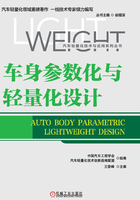
序
Preface
It is an honour for all those who contributed towards the successful development of SFE CON-CEPT that Jilin University is planning to publish a Auto Body Parametric Lightweight Design. As the founder and long -time President and CEO of SFE GmbH, I feel honoured to be asked to write a preface for this book.
Fundamental ideas underlying the development of SFE-CONCEPT
The early validation of new vehicle concepts is becoming increasingly important. This validation exercise must integrate many disciplines and make optimum use of the information available at each stage of development and quickly incorporate this information into the calculation models. The varlety of disciplines to be considered requires prioritisation in line with the respective stage of development and the depth of information.
The need for early functional validation inevitably changes the existing design and development process to very early CAE support for the design of carbodies or carbody components. In the early phase, the geometric mapping of a carbody and/or its components must be judged in terms of their usability for testing different functions and their flexibility for implementing the respective depth of information during the changing development process.
In vehicle development, a distinction has so far been made between the design of a new vehicle based on a predecessor vehicle on the one hand and a new development on the other. Hybrid forms are also conceivable where a new topology in the design structure and an unchanged topology in the floor assembly are desired. Development based on a predecessor vehicle generally uses the existing vehicle topology. Existing vehicle components and/or modules can in this case be adapted to the new target geometry. When developing a new vehicle, the possible vehicle topology must be based on the current state of knowledge of the vehicle design parameters, the main dimensions, boundary conditions, design methods, joining techniques, available package and styling information, etc. and the functional requirements to be secured.
The challenge is to optimally support the implementation of the specifications and requirements with a few software tools and to enable the software-based re-use of the resultant knowledge. Optimum support must also enable optimisation of materials, material thicknesses, geometric shapes and topologies in a closed chain.
The use of a parametric design tool during the concept phase must enable rapid variations of concept models. A precondition for this is component -spanning and implicit parametrics. Implicit parametrics is generated during topology and geometry creation. It is automatically derived by the geometry kernel of the program on the basis of user inputs. With the conventional process, it is very difficult for the user to define and set up explicit relations of explicit parametrics,especially for free-form surfaces. The concept models and/or design variants generated by SFE CONCEPT can be compared with each other in regard to the functions which are to be performed and used for shape and topology optimisation.
The completely new approach-i. e., to automated geometry generation on the basis of topological descriptions-yields immediate benefits for the industry.
During the modelling phase, a level of detail can be achieved that can be adapted to the requirements of the downstream analysis tools(Creash, NVH, etc.)and corresponds to the ‘detailed information’ available at any particular point in time. The derived FE meshes are free from initial penetrations and do not fall below the minimum permissible mesh edge lengths. The modular concept(library function)means that components already archived can be re-used and combined from components of different vehicles according to user-defined rules.
A comparison of the philosophy and approaches and of SFE CONCEPT on the one hand and a CAD system on the other reveals a number of fundamental differences. These differences also impact the implementability of the declared goal during the early vehicle development phase. This declared goal can also be defined as the merger of functional velidation and geometry identification.
The ‘shape’of an industrial product to be developed, such as a vehicle, is determined by a host of parameters. These include ‘real scalar’ parameters, such as wheelbase or tank capacity, as well as ‘abstract verbal’ parameters, such as vehicle type or legal requirements. In functional terms, the shape is, for instance, driven by crash and NVH requirements. Function, styling, packaging and many other criterial determine not only the choice of meterials, but also their geometric and topological characteristics. In a functionally driven design, it must be possible to create a sufficiently precise parametric geometry in a process that should be autometed to the maximum extent possible on the basis of the parameters which determine the ‘shape’-this is possible with SFE-CONCEPT.
Berlin,5 August,2018
Hans Zimmer

Founder, formet President and CEO, SFE GmbH